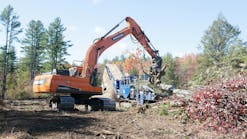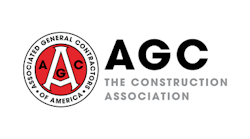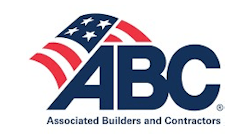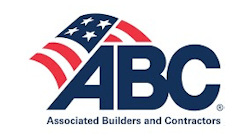The versatility of hydraulic excavators is virtually unmatched in the world of construction equipment.
Whether you’re talking about compact, mid-range or large hydraulic excavators, these machines can take on a variety of jobs in many different conditions by changing between dozens of approved attachments.
Other than excavating with a bucket attachment, one of the most frequent tasks performed by hydraulic excavators is that of lifting loads or materials. On the job site, excavators are used to lift, move, and place a wide range of materials. As a result, it is important that all operators of hydraulic excavators are trained to properly lift loads or materials.
Let’s begin with some of the fundamentals.
The rated lifting capacity of any hydraulic excavator is determined by two factors-hydraulic lift capacity and/or the tipping load. Hydraulic lift capacity is the point at which the excavator is limited by its hydraulic power to lift a load. Tipping load is just that-the point at which the excavator begins to tip or lift off the ground when lifting a load.
Manufacturers conduct tests according to ISO 10567 standards to determine how much weight the operator of the excavator can lift and swing at various heights and distances from the centerline of the machine. Based on these tests, manufacturers develop lift-capacity-or load-rating-charts, which are provided in the machine’s operation and maintenance manual and/or inside the cabin for the operator to use.
It’s important to know how to read and understand an excavator lift chart. At the top of the chart, there will be information indicating the machine configuration upon which the chart is based. There may be several lift charts for a large or mid-range excavator, based on various combinations of boom length, arm length, bucket size, counterweight size and track shoe width. According to Mike Stark, Doosan excavator product specialist, operators need to pay specific attention to whether or not the bucket weight is incorporated into the lift chart. This varies by manufacturer and can affect the operator’s ability to determine the lift accurately because the bucket may not match the bucket weight used for the lift chart.
Typically, rated loads marked with an asterisk are limited by the machine’s hydraulic capacity and do not exceed 87% of hydraulic lift capacity as tested. Rated loads without an asterisk are limited by the machine’s stability, or tipping capacity, and do not exceed 75% of the tipping load as tested.
The next thing you need to determine is the lift point height, which is in the far-left designated lift point. This height is not from the ground to the object you’re lifting. When you’re measuring the lift point height, consider how high you will need to lift the load, including the height of the load itself, the length of the lifting device (such as a chain or sling), and at what height you want to place the load (such as on a trailer).
Next, determine the lifting radius from the centerline of the swing point. This distance is shown in the top row of the lift chart. At this point, you need to determine if you are lifting over the front of the excavator or over the side. In addition, if you are using an excavator with a dozer blade or outriggers, such as a wheel excavator, you need to know if the lift charts are determined with the dozer blade or the outriggers in the up or down position.
Now find the cell on the lift chart where the lift point height and lifting radius intersect. The number shown is the excavator’s lifting capacity in pounds or kilograms. If the cell is blank, the excavator has no lifting capacity at that point, and lifting should not be attempted.
Generally, as you move to the right on a lift chart, lifting capacity will decline. Also, when lifting over the side of the excavator, the rated lifting capacity is generally lower than over the front of the excavator.
Be Alert for Job-Site Considerations
While understanding how to read a load-rating or lift-capacity chart is important for the operator, there are a number of other job-site factors that you or your operators must know when lifting loads or materials with an excavator. They include everything from the operating condition of the excavator, to the strength of the supporting surfaces beneath the excavator, to properly moving with the load suspended and even the weather conditions. Ultimately, the owner and/or the operator will be responsible for proper operation of the excavator under different job-site and lift-related conditions and must respond to changes in those conditions that could pose a hazard to the operator or others working with him.
Here are some examples of what to check before starting to lift loads or materials:
- The excavator should always be on a firm, level, and uniformly supporting surface. Do not attempt to lift on soft or uneven ground or slopes. Use the manufacturer’s designated lifting points.
- The excavator should not be modified or altered in any way and should be properly maintained.
- Always lift squarely over the side or over the front of the machine. If equipped, activate the lifting mode control on the excavator before using the machine for lifting loads or materials. Keep the load balanced and swing the load slowly and smoothly.
- Avoid traveling with a suspended load, swinging the load too quickly, or lifting with an uneven sling. Keep bystanders away and never swing loads or materials over other personnel or work equipment.
- If the surface area of the load is large enough, unexpected wind gusts can create excessive side load conditions. Tag lines held by workers on opposite sides of the load can help control the load and prevent side loading caused by wind gusts.
- Keep the designated lift point directly over the load. The load can become unbalanced if the line is twisted and starts to rotate. Use short slings to prevent excessive load swings and swaying.
- Remember that the weight of slings and any auxiliary lifting device (and/or the weight difference of any attachment heavier than the standard configuration) must be subtracted from the rated lift capacity to determine the correct net rated lift capacity. Do not use attachments that are not designed to lift loads or materials.
- Always try to keep the lifting eye straight below the centerline of the arm and bucket pin. That way, the weight of the load is being primarily supported only by the pin, and not by the bucket cylinder, link and link pins.
- Finally, if you have any questions, always consult the excavator’s operation and maintenance manual for more information.












